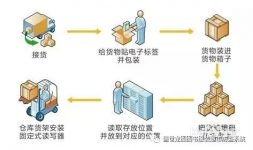
Wulianbao RFID warehouse material in and out management solution
[ad_1]
The RFID-based warehouse management system introduces RFID technology into the existing warehouse management, and automatically collects the data of each operation link such as warehouse arrival inspection, warehousing, outgoing, allocation, warehouse shifting, inventory counting, etc. Ensure the speed and accuracy of data input in all aspects of warehouse management, ensure that enterprises grasp the real data of inventory in a timely and accurate manner, and reasonably maintain and control enterprise inventory. Through scientific coding, it is also convenient to manage the batch and shelf life of items. Using the system’s location management function, you can also grasp the current location of all inventory materials in a timely manner, which is conducive to improving the efficiency of warehouse management.

1. Labeling management: The specific method is as follows:
1. Single product labeling: The initialized electronic label is delivered to the electronic label pasting process station. The staff of this station follow a special process (laminating, etc.) or manually paste the electronic label on the finished product to form a one-to-one correspondence.
2. Commodity packaging and marking: Commodities go through single product labeling, aggregation, packaging, packaging and labeling to complete the one-to-many correspondence relationship.
2. Warehousing management Warehousing management:
When the goods enter the warehouse through the conveyor belt of the arrival port, the reader writes the compressed barcode information of the entire pallet container into the electronic label, and then calculates the shipping position through the computer warehouse management information system, and sends the inventory instruction through the network system Go to the forklift truck system and store it in the corresponding cargo space as required. Outbound management: After receiving the shipping instruction, the forklift picks up the pallet goods at the designated cargo location. Forklift the front forklift reader to reconfirm the accuracy of the pallet products, and then send the pallet products to the conveyor belt at the outgoing port, and the conveyor belt reader at the outgoing port reads whether the pallet label information is accurate, and the product is shipped without error.
3. Inventory management manual inventory:
The warehouse manager uses the RFID handheld machine to read the label information of the goods in the warehouse, and check whether the real-time inventory data is consistent with the warehouse information statistics in the database. Fixed reader-writer real-time inventory: The reader-writer in the warehouse reads the label information of the goods in the warehouse in real time, and checks whether the real-time inventory data is consistent with the warehousing information counted in the database.
4. Warehouse management
Product storage: The storage order number is automatically generated when the finished product is stored, and different storage methods such as normal storage and returned storage can be distinguished.
Product delivery: For sales delivery or other delivery, the delivery order number can be automatically generated, and different delivery methods such as normal delivery and gift delivery can be distinguished;
Inventory management: manual management is not required. When entering and leaving the warehouse, the system automatically generates the inventory quantity of each type of product, which is convenient for query;
Transfer management: According to the need to transfer between different warehouses, the transfer order number can be automatically generated to support the arbitrary transfer of goods in different warehouses.
Inventory management: Users can take inventory of the warehouse at any time, and automatically generate inventory receipts, making inventory work convenient and quick.
Inventory upper limit alarm: When the inventory quantity does not meet a certain amount, the system alarms.
Query stats
Inquiry: Inquiry about incoming order, outgoing order, type product inquiry, inventory inquiry, etc. (user-defined); inquiry is inquired according to a certain condition: incoming date, outgoing date, outgoing customer, etc.
Statistics: At the end of the month, at the end of the quarter and at the end of the year, sales reports and inventory reports are automatically generated, and users can customize the reports that need statistics (product type, warehouse, operation actions-warehousing, outgoing, time, etc.).
System Management
System parameter setting, initial setting of basic business information and operating rules for business operations, including setting system parameters, coding rules, printing and receipt types, etc., to help users grasp business operation specifications and operation control.
Position management. This function adds position attributes in the warehouse and performs position management at the same time to enrich warehouse information and improve inventory management quality. It mainly includes basic data setting, warehouse position setting, initial data entry, daily business processing and even inventory query.
Shengshi Longtu (Beijing) IOT Technology Co., Ltd.’s IOT (English name: BESTIOT) is aimed at international brands based on RFID technology and the Internet of Things as the trend. The slogan positioning of “connected, intimate experience” focuses on library circulation automation management, confidential asset management, retail smart store management, hospital baby, student, elderly smart management, personnel management, smart city, smart elderly care, smart home, VR interconnection And other high-end intelligent fields.
[ad_2]



